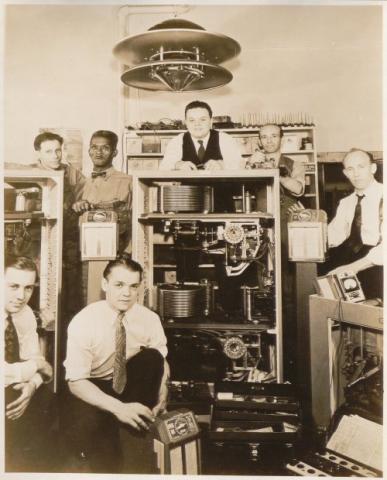
On this day in 1899, San Francisco's Palais Royale Saloon began operating the world's first forerunner to the jukebox. It was an Edison Class M Electric Phonograph, retrofitted with a coin slot invented and patented by entrepreneurs Louis Glass and William S. Arnold, who called their device a "nickel-in-the-slot player".
Unlike the machines that came later, the nickel-in-the-slot player could only accommodate a single record, which was changed out every day or so. It also lacked a system for amplifying sound; paying customers listened in on their purchase via one of four earpieces attached to the machine with a system of tubes. This device, and other variations on the coin-operated phonograph, would proliferate over the years before being replaced by Wurlitzer, who created the machine that we would today consider a "modern" jukebox in 1934.
This ca. 1940 photograph shows the employees of the Buckley Music System, a manufacturer and distributor of jukebox music systems for businesses. The company operations were active from 1939 through 1950 (exact incorporation and cessation date unknown). Headquartered in Chicago, Illinois, Buckley had several distributors in various regions around the United States. The jukebox stations were tied into a central system, including jukes, a full line of auxiliary wall and or bar boxes, and speakers.
Hagley Library's Buckley Music System, Inc. album (Accession 2016.301) is a salesman sample catalog marketing the Buckley jukebox system for restaurants, bars, and clubs. This album opens with three photographs of company employees and an image of a wall-mounted speaker cabinet. A majority of the photographs provide an interior view of empty or near-empty establishments that have implemented the system. These photographs feature architectural and interior design details, as well as advertising and point of sale displays for businesses from all across the United States. To view the digitized album online now, click here to visit its page in our Digital Archive.

